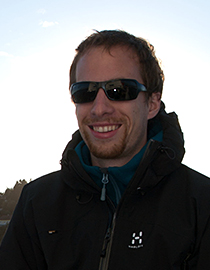Lukas Becker
Lukas Becker

I started my academic training at the Christian-Albrechts-University in Kiel, Germany with a BSc in Earth Science in 2007. During the four years I took half a year off for the training to become a certified European Scientific Diver. I specialised in marine environment and “climate and fossils”. My bachelor thesis focused on data derived from a sediment core from the Gulf of Guinea that covers the climate history of the last 130.000 years. I focused on the variability of the West-African monsoon system during MIS 1 and 5. The project was carried out under supervision of Professor R.R. Schneider.
I moved to Bergen, Norway for my Master of Science in Earth Science at the University of Bergen in 2011. I specialised in climate and quaternary geology. I collected erratic boulder samples for my master thesis on three Norwegian mountains in central, southern Norway to determine ice transport directions during the last 30 ka. The second part of the thesis focused on the genesis and source of blockfields on the peaks of the investigated mountains. This thesis was under supervision of Assoc. Professor H. Linge.
PhD Project
Just three months after my MSc was completed I started my PhD project at the University of Bergen in the marine research group in October 2013 under supervision of Professor H.P. Sejrup, H. Haflidason and B. Hjelstuen.
The main objective of this PhD-project is to study the interaction between the large NW-European ice sheets and the oceanic circulation in the Norwegian Sea towards the end of the last glaciation.
The project is generally sub-dived into two parts:
Project I will be a compilation of data derived from several sediment cores from the eastern Norwegian Sea. The focus will be on proxies of sea-surface condition, e.g. the IRD flux, sediment structure and -composition as well as stable isotope measurements on foraminifera. The aim is to enhance the knowledge of the impact of oceanic circulation on the Fennoscandian Ice Sheet (FIS), including the Norwegian Channel Ice Stream (NCIS) and vice versa throughout the last 40.000 years.
Project II will focus on a high-resolution Holocene reconstruction of contourite development along the Norwegian continental margin in regard to the variability in the ocean circulation and terrigenous influx into the southern Norwegian Sea.
Both projects will use a set of new and previously published sediment cores obtained on and off the southern Norwegian continental slope. The positions of these coring sites allows to record the variations in oceanic circulation as well as in changing terrigenous input from the NW-European ice sheets.
All sampling localities are in close proximity of the Norwegian Atlantic Current (NwAC) and the outer limit of the FIS and the British-Irish Ice Sheets (BIIS) during maximum ice extents. This project will extend the existing database with new measurements, additional cores and updated age models.
LATEST NEWS
GLANAM NEWSLETTERS
- GLANAM Newsletter 13 – October 2016
- GLANAM Newsletter 12 – August 2016
- GLANAM Newsletter 11 – June 2016
- GLANAM Newsletter 10 – April 2016
- GLANAM Newsletter 9 – February 2016
- GLANAM Newsletter 8 – December 2015
- GLANAM Newsletter 7 – October 2015
- GLANAM Newsletter 6 – August 2015
- GLANAM Newsletter 5 – June 2015
- GLANAM Newsletter 4 – April 2015
- GLANAM Newsletter 3 – February 2015
- GLANAM Newsletter 2 – April 2014
- GLANAM Newsletter 1 – November 2013
